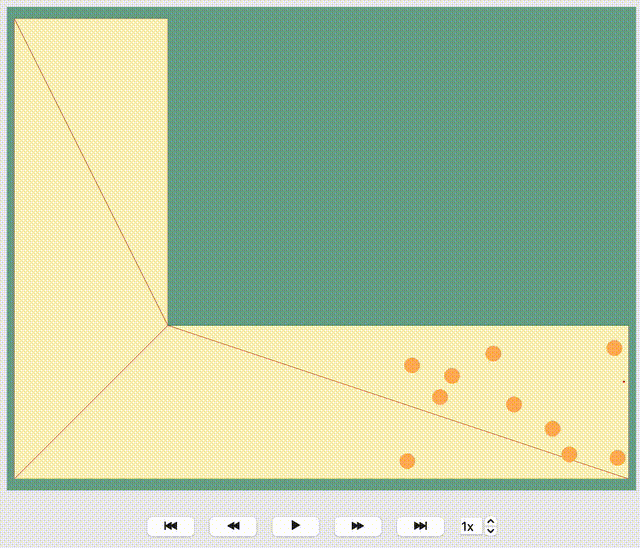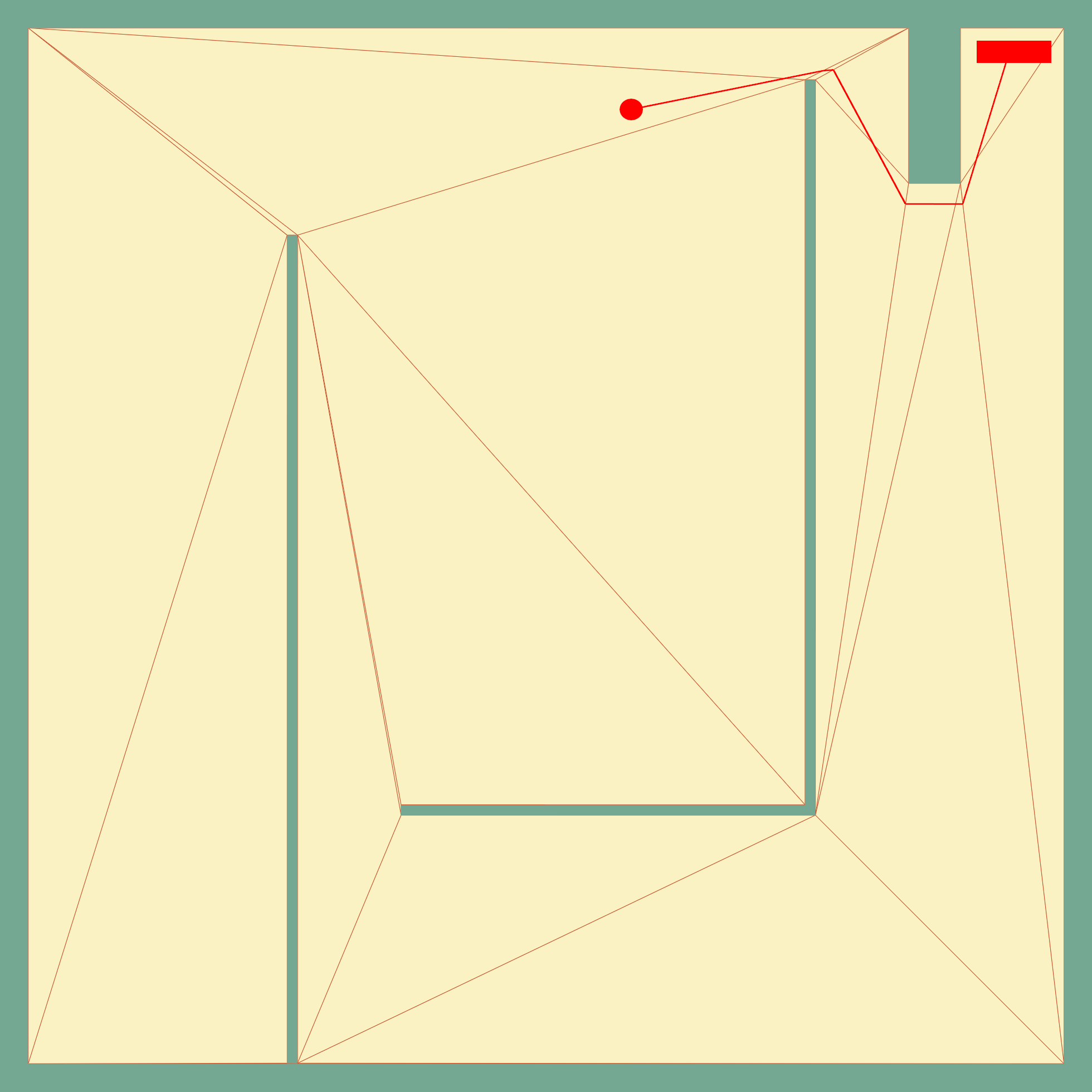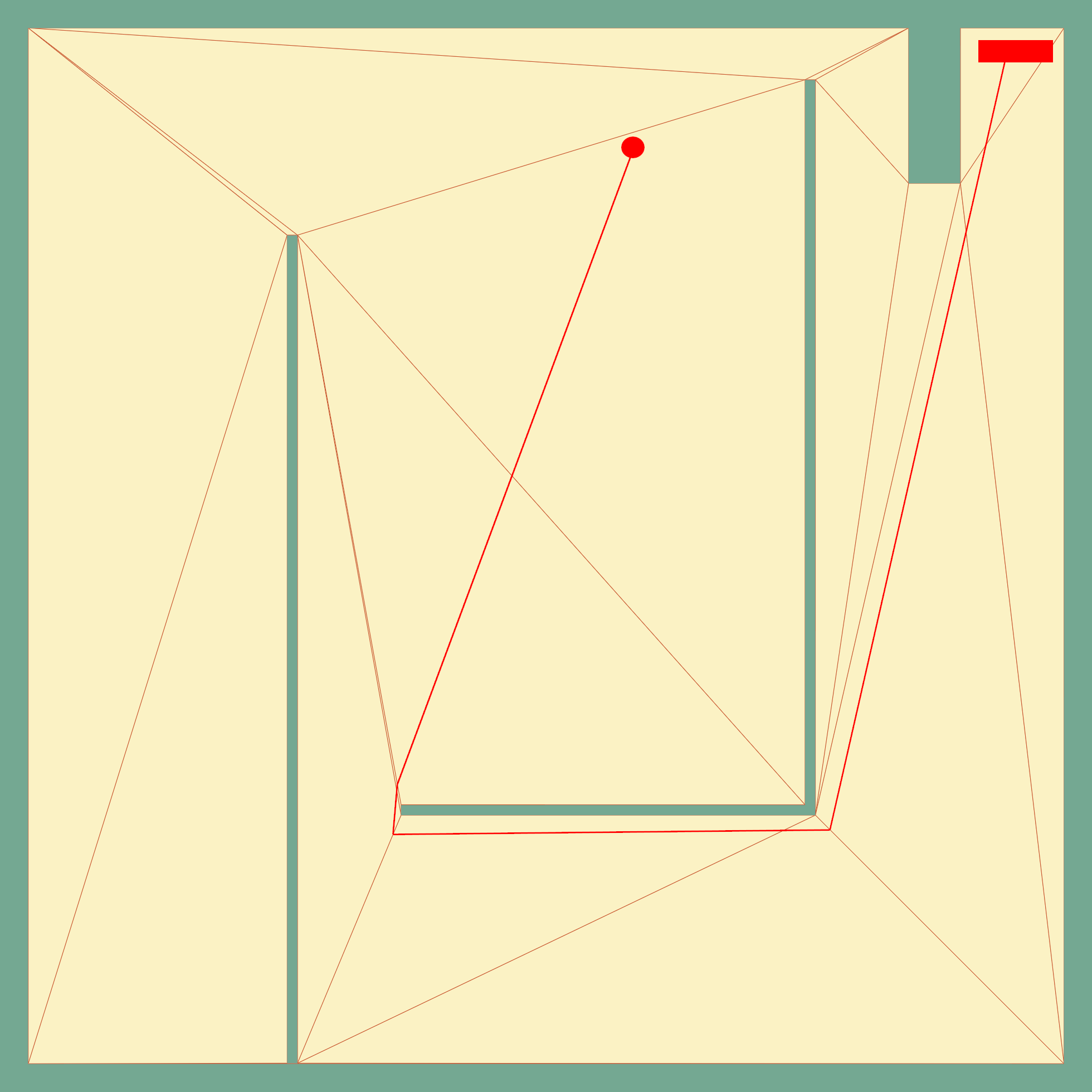Routing#
Routing in pedestrian dynamics simulations refers to the process of determining how individuals navigate through a physical environment, such as a street, building, or public space. In JuPedSim this consists of two fundamental parts:
- Route planning:
Route planning models the decision-making process of the agents on their route through the simulation. On base of the underlying route, the target of the agents is distinguished. These may include condition-based decisions, where the way of different agents on the same route may differ.
- Way finding:
Wayfinding is the process by which agents decide on a route to reach their target. This process typically considers factors like the agent’s goal (target), the layout of the environment, available pathways, and the agent’s knowledge of the surroundings.
For more information how this can be included in a JuPedSim simulation, and what the underlying principles are, see the following sections.
Route planning#
For modeling complex scenarios in which the agents will move through different specific targets on their way, it is possible to define routes. These routes are modeled as a network, where each target is a node, and the nodes can be connected, indicating how the agent might continue their route. The illustration of such a network can be seen below:
Graphical representation of the underlying routing network of a more complex simulation. Each circle represents a intermediate stage, and the arrows the corresponding connections.#
In the following sections, we will explain how to set-up such routing networks in JuPedSim.
Stages#
A stage in JuPedSim is an intermediate target the agent wants to reach. When a stage is reached, the agent will wait for its completion and then continue to the next stage. A stage may already count as completed when the stage is reached or when some condition is fulfilled. These different kind of stages will be explained below.
Waypoint#
The most fundamental kind of stage is a Waypoint, it represents a target the agent need to reach.
For the way finding, the agent always targets the Waypoint directly.
A Waypoint counts as completed when the agents reach a specified distance from the defined Waypoint.
The figure belows shows how a Waypoint is used in the simulation, here the center (orange) is the Waypoint and the blue area marks which an agent needs to reach to complete the stage.
Representation of a Waypoint (orange) with the given distance (orange line).#
A Waypoint at \((0.6, -1.4)\) with an accepted distance of 2m can be added to the simulation via:
waypoint_id = simulation.add_waypoint_stage([0.6, -1.4], 2)
Exit#
An other stage is an Exit, which as the name describe, model exits of the simulation.
It marks an area, at which agents will be marked for removal from the simulation when they reach it.
The removal itself is done at the beginning of the next iteration step.
As a target the agents will aim for the center of the exit polygon.
Note
Agents will be removed from the simulation when they reach the designated exit area.
Representation of an Exit (blue). The agents will aim for the center (orange).#
An exit located in the polygon \((-0.2, -1.9), (0.2, -1.9), (0.2, -1.7), (-0.2, -1.7)\) can be added to the simulation via:
# create exit from coordinates
exit_id = simulation.add_exit_stage([(-0.2, -1.9), (0.2, -1.9), (0.2, -1.7), (-0.2, -1.7)])
# create exit from shapely.Polygon
exit_polygon = shapely.Polygon([(-0.2, -1.9), (0.2, -1.9), (0.2, -1.7), (-0.2, -1.7)])
exit_id = simulation.add_exit_stage(exit_polygon)
Warning
As the pedestrians currently aim for the center of the exit area, defining wide exits may lead to unexpected behavior. In some case it might be more suitable to define multiple exits instead one wide one.
Waiting Queue#
It is not only possible to steer agents with waypoints, it is also possible to let them wait in queues.
JuPedSim offers Queues where the agents will wait at predefined positions.
The provided positions are ordered by their order of definition, and agents will wait on the first empty spot.
When agents leave the queue, the other agents will move up in their waiting positions until they reach the front.
To release agents from the queue, a signal needs to be send to the queue, signaling that the first n agents can leave it.
Note
When there are more agents arriving at the queue then waiting positions are available, all overflow agents will wait at the last waiting position.
Representation of an Queue (dots).
The first position is marked orange and the last position light-blue.
The movement of the agents to move up the queue is indicated by the red arrows.#
The following code snippet creates a Queue with five waiting spots at (0, 0), (0, 5), (0, 10), (0, 15), and (0, 20) and adds it to the simulation. Afterwards, it retrieves the Queue object from the simulation and then releases the first two and then the first agent from the simulation.
# add the queue to the simulation
queue_id = simulation.add_queue_stage(
[
(0, 0),
(0, 5),
(0, 10),
(0, 15),
(0, 20),
)
# retrieve queue from the simulation
queue = simulation.get_stage(queue_id)
...
# notify that the first 2 agents can move to the next stage
queue.pop(2)
# notify that the first agent can move to the next stage
queue.pop(1)
Waiting Set#
A second option to introduce a waiting stage to the simulation are WaitingSets.
They consists of multiple waiting positions which will be filled in the order of their definition, when creating the waiting set.
A waiting set can either be active, which means the agents will wait there, or inactive, which will release all waiting agents.
If a waiting set is inactive when an agents targets it, the first defined waiting position will be used as a waypoint.
Note
When more agent target the waiting set, than available waiting spots, the overflow agents will wait at the last entered waiting position.
Representation of an WaitingSet.
The first (orange) and last defined position (blue) are highlighted.#
In the following, you can see how to add a waiting set to a simulation and how to activate and deactivate it:
# add the waiting set to the simulation
waiting_set_id = simulation.add_waiting_set_stage(
[
(60, 50),
(59, 50),
(58, 50),
]
)
# retrieve waiting set from the simulation
waiting_set = simulation.get_stage(waiting_set_id)
...
# deactivate the waiting
waiting_set.state = jupedsim.WaitingSetState.INACTIVE
...
# activate the waiting again
waiting_set.state = jupedsim.WaitingSetState.ACTIVE
Journeys#
Multiple stages can be combined into what in JuPedSim is called a Journey.
For creating more complex routes in JuPedSim multiple stages can be combined to a so called Journey. For
# create stages
...
# define a journey
journey = jps.JourneyDescription(
[
waypoint_id,
queue_id,
waiting_set_id,
exit_id
]
)
Transitions#
Now, we have Journey with a set of stages which have no connection to each other. But for creating the complete routing set-up we need to define theses connections, the so called Transitions. They define, which stage an agents target after its current one is completed. JuPedSim offers different types of connections directly to model some decision making processes.
Note
When adding the transitions to your journeys make sure, that Exits are only added at the end of a trip. Otherwise the agents will be removed from the simulation when they reach the exit and will not continue to the next stage.
Fixed transition#
The simplest kind of transition is to define that the agent will continue its journey with one specific next stage.
journey.set_transition_for_stage(
start_stage_id,
jps.Transition.create_fixed_transition(next_stage_id)
)
Round-robin transition#
It is also possible to model a decision making process and split the agents at a stage, with a round-robin transition. Here, the agents will proceed in a weighted round-robin manner. E.g., when defining a round robin transition with three outgoing stages and the corresponding weights 10, 5, 1, the first 10 agents to make a choice will continue with the first given stage. The next 4 with the second one, and the next agent will continue with the third stage. Then the circle starts again at stage one.
How to create such a round-robin transition as described above see here:
journey.set_transition_for_stage(
start_stage_id,
jps.Transition.create_round_robin_transition(
[
(first_candidate_stage_id, 10),
(second_candidate_stage_id, 5),
(third_candidate_stage_id, 1),
]
)
)
Least-targeted transition#
An other option to model decision making processes, is the least-targeted transition. The next stage is determined from a list of candidates by checking which of the candidates has the least number of agents targeting it already. When multiple stages have the same number of agent targeting the first defined will be chosen.
A least targeted transition can be added to a journey with:
journey.set_transition_for_stage(
start_stage_id,
jps.Transition.create_least_targeted_transition(
[
first_candidate_stage_id,
second_candidate_stage_id,
third_candidate_stage_id,
]
)
)
Way finding#
Depending on the principles explained above each agent gets a target assigned, there they head to. Now, the route towards this goal needs to be determined. For distinguishing the route JuPedSim triangulates the geometry and computes the distance between two points through the triangulation. Here, it will compute the distance between the centers of two neighboring triangles. When multiple paths lead to the target, the shortest one will be preferred.
How the path is distinguished for different target points, you can see in the animation below:

Warning
As the distance is computed along the centers of the triangles, it may happen, that not the shortest-path on the ground is taken. This is a known issue of the JuPedSim’s routing, it will be fixed in the near future. To avoid is behaviour intermediate waypoints can be added to the simulation.

